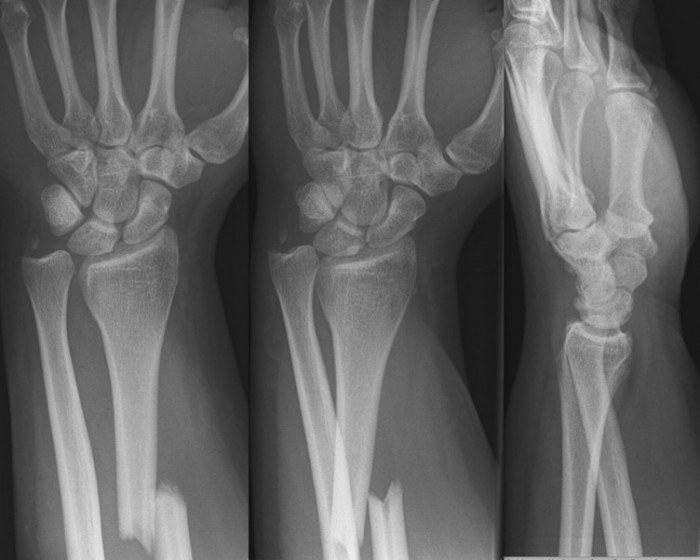A fracture or crack in any bone in the body is called a fracture. Fractures are normally because of harm from a fall but they can result from spells of coughing or even a hug if the bones are seriously osteoporotic.
Fractures as a result of bone being twisted or turned happen in athletic sports like skiing or rugby. Susceptibility to fractures increases with the bone ailment osteoporosis, which primarily affects women after the menopause and results in fragile bones. Fractures that occur in bones changed by tumours are called pathological fractures and may happen after minimal harm or even spontaneously. Greenstick fractures happen when a long bone bends and cracks on one side only; these fractures are particularly common in kids.
What Are The Kinds?
There are two primary kinds of fracture: closed (simple), where the broken bone doesn’t fracture through the overlying skin, and open (compound), where the bone pierces the skin and is exposed. Open fractures are more serious due to the risk of infection and damage to nerves and blood vessels.
Transverse Fracture
In a transverse fracture, there’s a straight fracture across a bone. Transverse fractures, usually in the arm or leg, are generally expected to a Strong strike, like that sustained in a crash during a road traffic injury.
Coil Fracture
Coil fractures, or oblique fractures, are generally caused by Unexpected, violent, rotating Moves, like wriggling the leg during a fall, particularly if there’s a ski on the end of it.
Greenstick Fracture
If a long bone in the arm or leg Curves, it may snap on one side exclusively, creating an incomplete fracture called a “greenstick” fracture. This kind of fracture occurs in youngsters, whose bones continue to be growing and bendy.
Comminuted Fracture
The bone is broken into little fragments, which raises the Chance of damage to the soft tissues surrounding the broken bone. These fractures are generally brought on by intense, direct powers.
Avulsion Fracture
A section of bone is pulled away from the chief bone by a tendon that attaches a muscle to a bone. It generally results from a sudden violent contraction of the muscle.
Compression Fracture
A compression fracture Happens if spongy bone, like that in the vertebrae of the spinal column, is smashed; This kind of fracture is Frequently as a result of osteoporosis.
Stress Fracture
Fractures are due to continued jarring of a bone are called stress fractures. They may appear in the foot bones or shin bones of long-distance runners. In the elderly, fractures may result from mild stress including a persistent cough, which can fracture a rib.
What Are The Symptoms?
The symptoms of a fracture depend on its type and contain:
- deformity in the affected region
- pain and tenderness, which restricts motion
- swelling and bruising
- crackling sound due to grating of the ends of the bones on motion or pressure
- in an open fracture, damage to skin, bleeding and observable bone.
All fractures cause a particular amount of internal bleeding due to damage to blood vessels in the bone. The broken bone ends may cause additional bleeding by damaging tissues and blood vessels in the wounded region. In some fractures, especially a fracture in the thighbone (femur), blood loss may be serious and bring about shock.
Various complications may be related with a fracture. For instance, if you fracture a rib, there’s a danger the broken rib may puncture a lung, causing pneumothorax.
Postponement in treating a fracture correctly may bring about failure of the bone to heal, causing long-term deformity or handicap. Consult a physician promptly if you believe you’ve a fracture.
How Is It Diagnosed?
Your physician will arrange for you to have X rays to show the kind and extent of the fracture. CT scan or MRI may be needed to investigate complicated fractures. If a fracture wasn’t due to injury, your physician may check for a potential underlying illness that could have weakened your bones.
What’s The Treatment?
If the broken ends of the bone have been displaced, they are going to be brought into line to restore regular shape by exploitation. This procedure is called decrease. Each kind of fracture has its own manipulation manoeuvre, which might be carried out under local or general anaesthetic.
Test X-Rays
X-ray photography is among the earliest methods of imaging the body. In this technique high-strength radiation (in the kind of X rays) passes through the body to form an image on picture set on the other side of the body. Tough structures within the body, for example bones, block the radiation and so appear on the X-ray film as white regions. Xrays are so useful for imaging tough structures but aren’t really useful for imaging soft tissues, like the liver, since they don’t obstruct the radiation. Nevertheless, a particular kind of X-ray, known as a comparison X-ray, may be used to picture specific soft tissues.
During an X-ray, the source of the X-rays is generally placed right above the place to be analyzed. You’ll be requested to keep completely still during the process to ensure that the X-ray picture is clear. You may be exposed to X-ray radiation for less than one second, and the process generally takes just a couple of minutes.


 (49 votes, average: 4.88 out of 5)
(49 votes, average: 4.88 out of 5)